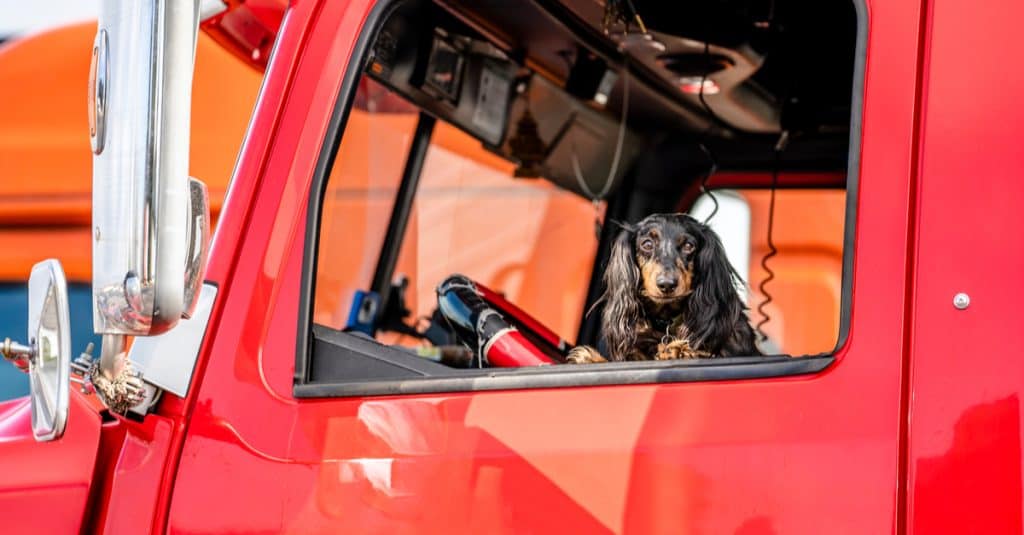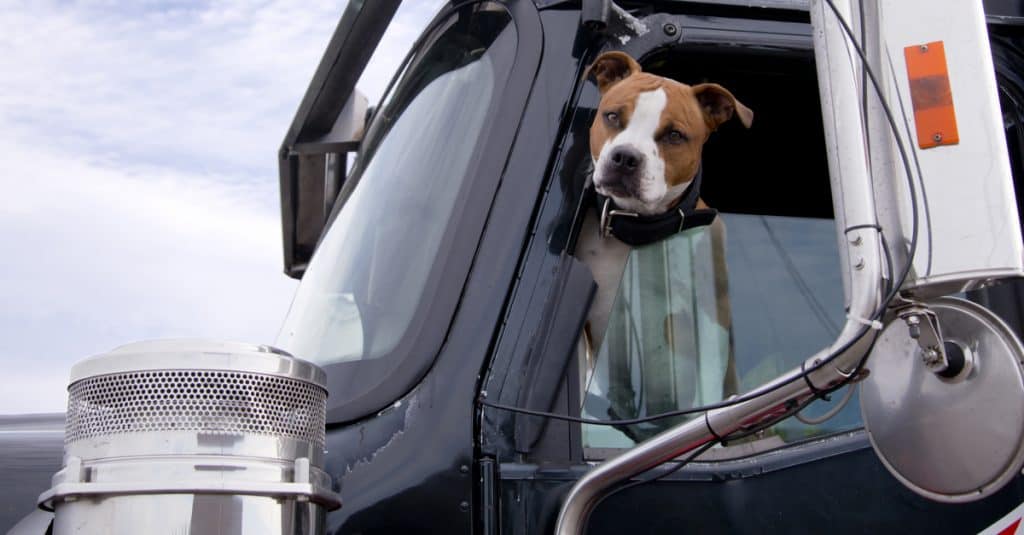“This post contains affiliate links, and I will be compensated if you make a purchase after clicking on my links.”
Written by Ethan Smith of Commercial Truck Trader
Did you know that over 60% of OTR drivers are pet-owners, and that 40% take their pets on the road with them?? That’s according to a recent Harris poll, and it got us thinking about trucking with man’s best friend.
Bringing a dog on the road creates a fun and unique trucking experience, but there can actually be a lot that goes into preparing for and driving with a canine in the cab. Here’s what you need to know about Trucking with Dogs!

Reasons for Truckers to Get a Dog:
• Companionship: Trucking can be a lonely profession, and dogs are great companions!! The presence of an optimistic pup in the front seat can help drivers combat feelings of boredom, isolation, and sadness.
• Stress Relief: Pets also help alleviate stress, which can have positive impacts for physical health too, like improvements in cholesterol and blood pressure.
• Meet New People: Most people are dog-people, even if they’re cat-people. Walking your dog around the rest stop or local park is a great way to break the ice and make new friends. Many individuals will want to stop to pet and speak to your pup, making dog-ownership a great way to get some good ol’ fashioned human contact outside the cab.
• Exercise: Speaking of walks, having the responsibility of getting your canine some exercise is a great way to keep yourself active and healthy too!
• Protection: As friendly as they are, dogs can also serve as fantastic alert systems, with highly sensitive ears and protective instincts that make them likely to bark a warning to you if they sense a threat.
• No More Dog-Sitters: Finally, taking your dog on the road with you means you never have to leave them at home with someone else. We get attached to our pets, but if you’re willing to adequately prepare for having a canine in the cab, you never have to be separated again! And speaking of preparing…
What Truckers Should Know Before Getting a Dog
• Permission: Check with your company to be sure a dog is allowed in the cab for long trips. And check with facilities to which you are delivering if pets are allowed inside the gate. If not, you’ll have to acquire a decently comfortable crate or carrier.
• Personal Readiness: Objectively reflect and make sure you’re experienced enough as a driver before adding what could become a distraction into the cab. Safety should always come first. Also, ensure that you are ready and willing to take on the added responsibility of caring for another living creature. Shelters are tragically filled with pups abandoned by people who weren’t ready for the commitment.
• Research the Breeds: Know what type of dog is best for a trucking companion. Calmer breeds and older dogs are most at-ease in the cab, and some breeds will shed less on your seats than others. And as much as you may want a big dog, smaller pups — 50lbs or less — often work best for life in a semi. The bigger the dog, the less space you’ll both have.
• Adopt! Adopt! Adopt! There are so many dogs in need of good home, a shelter should always be the first place to check for a new furry companion. In addition to young pups, shelters will have “grown-up” dogs who are house-trained, calmer, and more suited to life on the road.

Sharing the Cab with Your Dog
• Do Some Shots: Get your dog the proper veterinary shots and keep vaccination records with you in case they’re needed.
• Consistent Feeding: Bring along sufficient dog food and serve recommended portions each day to keep your canine healthy. Also be sure they have plenty of opportunity to drink water, especially on hot days.
• Keep Things Clean: Invest a few dollars in dry shampoo and baby wipes to maintain your pet’s cleanliness and prevent smell. To cut down on shedded hair getting everywhere, regularly engage in brushing, bathing, washing their bedding, and changing out your AC/heat filters. And of course, learn how long your pet can reasonably “hold it” and bring cleaning supplies in case you can’t find a rest stop in time.
• Safety First: Train your dog to keep away from your clutch and brakes, which may require you to set up a makeshift barrier for at least the first few weeks. You may want to consider securing them more fully to save them from injury if you brake suddenly. Finally, keep in mind that jumping in and out of a cab can really hurt a pup’s hips, back, and other joints, especially if you’ve got an older dog. Remember to lift them when you can, or purchase a pet loader.
• Keep Things Interesting: Make sure your dog can stimulate their bodies and their minds. In addition to chew toys that keep them interested while in the cab, you’ll want to get a leash — and maybe some more durable toys — for walks and outside play that can provide the minimum of one hour of exercise per day that they need to stay healthy.
• A Safe Place: Hopefully you can create a designated spot that’s safe & comfortable for your canine companion. Especially if they’re new to the cab, your dog should have a space where they can relax and feel secure. And remember that despite having fur, dogs can get cold too. If you’re driving up north or driving in the winter, pack a blanket for your pup, especially if they’re a short-haired or smaller breed.
Ethan Smith is a Content Curator for Trader Interactive, serving the commercial brands Commercial Truck Trader, Commercial Web Services, and Equipment Trader. Ethan believes in using accessible language to elevate conversations about industry topics relevant to commercial dealers and their buyers.


















Now I know why I see so many dogs in big rigs.